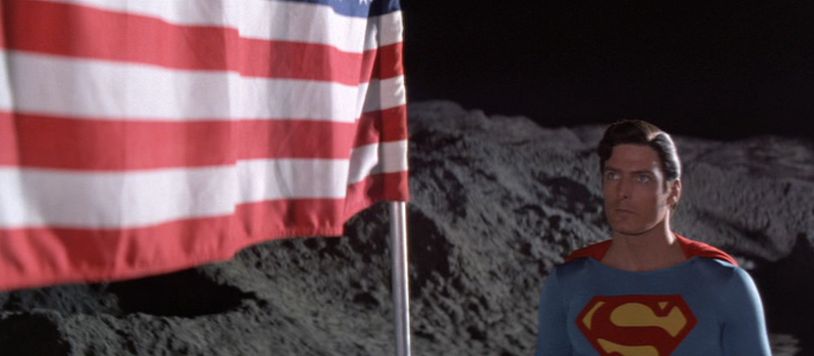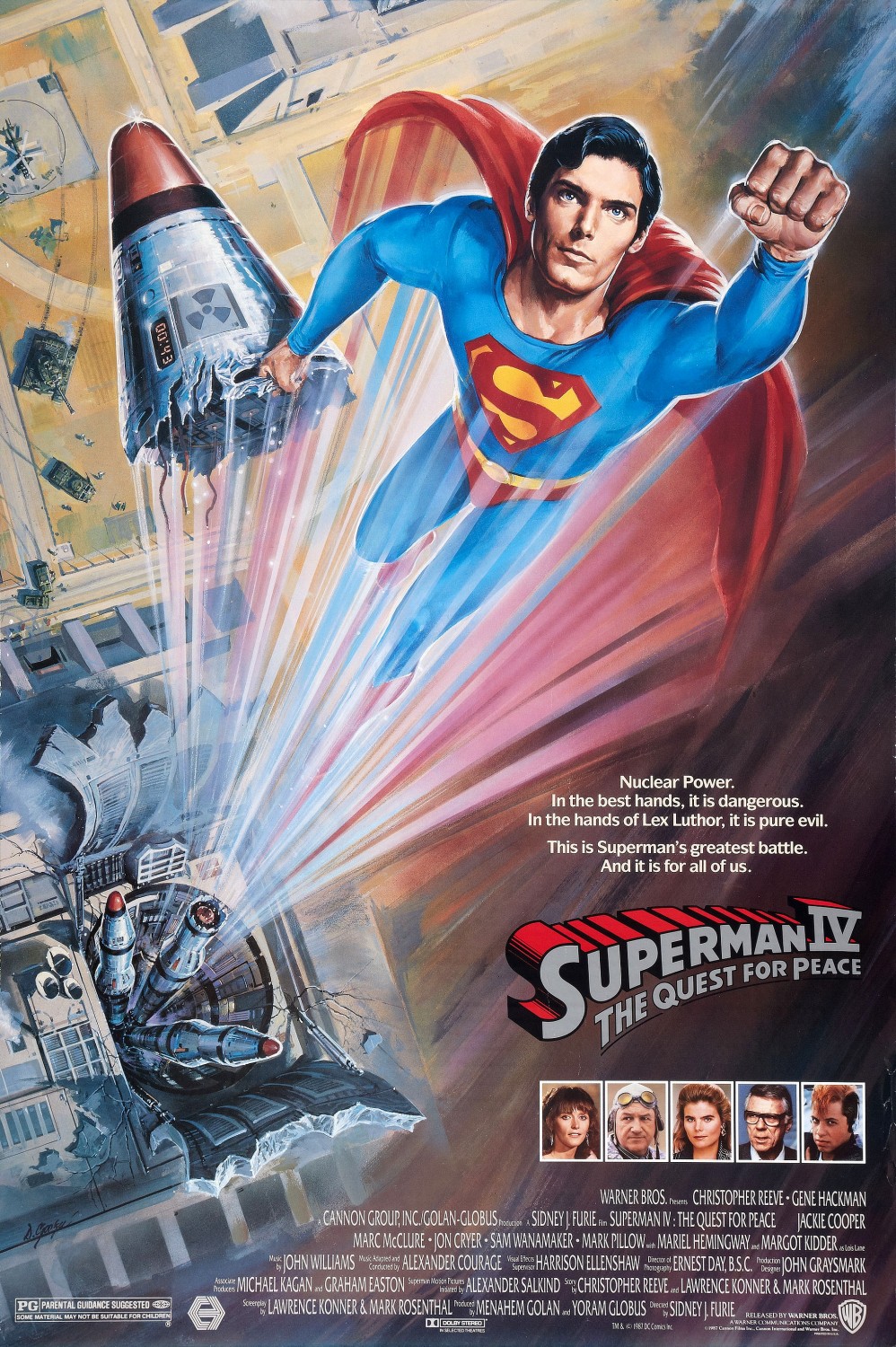

“I just wish you could all see the Earth the way that I see it.”
Christopher Reeve turns in his final performance as Superman and the franchise stumbles to a halt in the much-maligned Superman IV: The Quest for Peace. Shot for less than half of the budget of Superman III, Sidney Furie’s film is noticeably less developed, though it does not delve to quite the level of self-parody that the third film does. Margot Kidder returns as Lois Lane and Superman becomes an American patriot while saving the world from nuclear destruction. A new foe—Nuclear Man—is created by Lex Luthor (Gene Hackman) launching a genetic matrix containing a strand of Superman’s hair into the sun. While it is easier to take seriously than a superhero film starring Richard Pryor, it is less competently made than the third film, let alone Superman or Superman II.
Believing that the series had run its course, Ilya Salkind, who had produced the first three films along with his father, sold the rights to Cannon Films. Cannon mostly pumped out low-budget schlock like Delta Force, The Texas Chainsaw Massacre 2, and Masters of the Universe, but occasionally they would finance arthouse films like Love Streams, King Lear, or Powaqqatsi. The production value is very suspect here. Sets are limited in size and scope, visual effects are worse than they were in the original (even though technology had gotten much better in the decade between them), and when Superman approaches the U.N. headquarters he is really entering a dressed up bus station. There are several shots where the wires that allow Reeve to fly are clearly visible.

The film’s sci-fi-lite plot is cheesy. Lex Luthor and his halfwit nephew Lenny (Jon Cryer) create the Adonis-esque Nuclear Man (Mark Pillow) without much trouble1 and Superman gets raked by his radioactive claws and contracts radiation sickness. Mark Pillow is basically a Dolph Lundgren stand-in (Lundgren was busy making Masters of the Universe), and his voice is dubbed over by Gene Hackman. The outlook is incredibly naive, as Superman’s request to disarm the world’s nuclear arsenal is applauded rather than resisted. There’s lots of cheap fight scenes and slow-motion punches on the moon,2 but it’s all pretty bland and lacks tension. Superman spends half an hour simply cleaning up as Nuclear Man leaves a trail of destruction—he rebuilds the Great Wall of China brick by brick, replaces the Statue of Liberty, and plugs an erupting volcano by slicing off the top of a mountain, inverting it, and plugging the flow of lava.

While the actual cinematic elements are so poor that the film falls flat on its face, it does have some heart, preferring to wear it on its sleeve. At the beginning of the film, The Daily Planet is bought out by a mogul (Sam Wanamaker) who wants to turn it into a sensationalist tabloid in order to increase its profits. He takes Superman’s words out of context and prints them as headlines, and later speculates on his death. He installs his daughter Lacy (Mariel Hemingway) as the head of the Daily Planet, but she gradually comes to understand the value of integrity and commitment to the truth. She falls in love with the awkward and bumbling Clark, which leads to an amusing/annoying scene in which Lois and Lacy are supposed to go on a double date with Superman and Clark, respectively. It works for about a minute before becoming tiresome. Lacy also takes a cue from Lois and begins to dress modestly because, as Lois explains, Clark is the oldest living boy scout and will not care how low the cut of her dress is.

Once again, the bright spots are the quieter moments when Superman isn’t saving a cheap production set from total annihilation. Early in the film, Clark travels to Smallville where he meets with a realtor to discuss selling his parents’ old farm, and the scene is appropriately sentimental. The first assignment that Lacy gives to Clark upon becoming his boss is a series on the nightlife of Metropolis, which leads to a fun, super 1980s scene in which Clark and Lacy attend a group aerobics class together. A gym instructor tries to embarrass the oversized dork in front of his lady-friend, but Clark is able to get his revenge by chucking a yoked barbell on top of him later when no one is looking. “Uh, no pain no gain,” Clark says, throwing the jock’s mantra back at him. Kidder is once again great as Lois Lane. Her comedic timing, even in throwaway, just-get-us-to-the-next-scene dialogue, is fun and charming. She even gets to deliver a tearful monologue about how much Superman has meant to her. She delivers the line to Clark, who she believes is sick with the flu (and not dying from nuclear poisoning). It’s a touching moment and reinforces the point that the Superman mythos is centered around this specific relationship as much as it is about his compassion for humanity in general.
Comparing Superman IV to either of the first two films (or Superman II: The Richard Donner Cut), its shortcomings are obvious. Cheap special effects, a patchy script, and huge creative liberties regarding the physical laws of the universe (women can apparently breath in space). But it’s tough to call it worse than Superman III, which had a decent budget behind it and was still a train wreck. At least many of the flaws of IV can be explained away by financial constraints.
It’s possible that, given a budget to match the previous films, Christopher Reeve would have had a few more outings as The Man of Steel. Instead, we get a B-movie that ran a dying series further into the ground. It’s only worth watching today because it continues the adventures of the characters you’ve already invested six hours into.
1. There is a fun deleted scene where they create a prototype that emerges from the test chamber three-quarters nude and lacking in coordination.
2. Superman even makes sure to straighten up the American flag placed there by Neil Armstong in 1969.